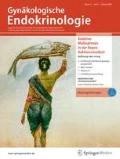Zusammenfassung
Sekundäre Amenorrhö und Infertilität sind ein häufiger Konsultationsgrund. Eine Hyperprolaktinämie muss ätiologisch immer ausgeschlossen werden. Prolaktinome stellen die häufigste Ursache einer symptomatischen Hyperprolaktinämie dar. Therapeutisch werden hier primär Dopaminagonisten eingesetzt, die meist zu einer Normalisierung von Prolaktin und daraufhin zur Wiederherstellung von ovulatorischen Zyklen führen. Ebenfalls häufig ist die medikamentös bedingte Hyperprolaktinämie, die am häufigsten durch Neuroleptika (D2-Antagonisten) bedingt ist, aber auch durch andere Medikamentenklassen verursacht werden kann. Das Ausmaß der Hyperprolaktinämie kann auch bei neueren Neuroleptika unterschiedlich sein. Nach Ausschluss eines Prolaktinoms und bei negativer Medikamentenanamnese sollte an seltenere Ursachen einer Hyperprolaktinämie gedacht werden. Schließlich sollten gewisse labortechnische Fallen bei der Interpretation von Prolaktinwerten in Betracht gezogen werden (Makroprolaktin, Hook-Effekt).
Abstract
Secondary amenorrhea and infertility are frequent reasons for consultation. Hyperprolactinemia must always be ruled out as a possible etiology. Prolactinomas represent the most common cause of symptomatic hyperprolactinemia and dopamine agonists are the first line therapy, mostly leading to a normalization of prolactin levels and restoration of ovulatory cycles. Drug-induced hyperprolactinemia is also common, particularly with neuroleptic drugs (D2 antagonists) but also with other mainly psychotropic drug classes: however, the degree of prolactin elevation can vary considerably even with the use of newer neuroleptic drugs. If a prolactinoma has been ruled out and medication history is not contributory, rarer causes of hyperprolactinemia should be considered. Finally, analytical pitfalls should be taken into account in the interpretation of prolactin levels (e.g. macroprolactin and the hook effect).


Literatur
Grattan DR (2015) 60 Years of neuroendocrinology: The hypothalamo-prolactin axis. J Endocrinol 226(2):T101–T122
Grattan DR (2008) Pregnancy-induced adaptation in the neuroendocrine control of prolactin secretion. J Neuroendocrinol 20(4):497–507
Torner L (2002) The brain prolactin system: Involvement in stress response adaptations in lactation. Stress 5(4):249–257
Wong A (2015) Update on prolactinomas. Part 1: Clinical manifestations and diagnostic challenges. J Clin Neurosci 22(10):1562–1567 (Oct)
Melmed S (2011) Diagnosis and treatment of hyperprolactinemia: An Endocrine Society clinical practice guideline. J Clin Endocrinol Metab 96(2):273–288
Glezer A (2015) Prolactinomas. Endocrinol Metab Clin North Am 44(1):71–78
Webster J (1999) Dopamine agonist therapy in hyperprolactinemia. J Reprod Med 44(12 Suppl):1105–1110
Wong A (2015) Update on prolactinomas. Part 2: Treatment and management strategies. J Clin Neurosci 22(10):1568–1574
Webster J (1994) A comparison of cabergoline and bromocriptine in the treatment of hyperprolactinemic amenorrhea. Cabergoline Comparative Study Group. N Engl J Med 331(14):904–909
De Vecchis R, Esposito C, Ariano C (2013) Cabergoline use and risk of fibrosis and insufficiency of cardiac valves. Meta-analysis of observational studies. Herz 38(6):618–628
Drake WM, Stiles CE, Howlett TA, Toogood AA, Bevan JS, Steeds RP, UK Dopamine Agonist Valvulopathy Group (2014) A cross-sectional study of the prevalence of cardiac valvular abnormalities in hyperprolactinemic patients treated with ergot-derived dopamine agonists. J Clin Endocrinol Metab 99(1):90–96
Colao A (2003) Withdrawal of long-term cabergoline therapy for tumoral and nontumoral hyperprolactinemia. N Engl J Med 349(21):2023–2033
Smith TR (2015) Current indications for the surgical treatment of prolactinomas. J Clin Neurosci 22(11):1785–1791
Liu JK (2004) Contemporary management of prolactinomas. Neurosurg Focus 16(4):E2
Mallea-Gil MS (2016) Prolactinomas: Evolution after menopause. Arch Endocrinol Metab 60(1):42–46
Faje AT (2015) The treatment of hyperprolactinemia in postmenopausal women with prolactin-secreting microadenomas: Cons. Endocrine 48(1):79–82
Peuskens J (2014) The effect of novel and newly approved antipsychotics on serum prolactin levels: A comprehensive review. CNS Drugs 28(5):421–453
Newey PJ (2013) Mutant prolactin receptor and familial hyperprolactinemia. N Engl J Med 369:2012–2020
Snyder PJ (1973) Thyroid hormone inhibition of the prolactin response to thyrotropin-releasing hormone. J Clin Invest 52(9):2324–2329
Grubb MR (1987) Patients with primary hypothyroidism presenting as prolactinomas. Am J Med 83(4):765–769
Ress C (2014) Serum prolactin in advanced chronic liver disease. Horm Metab Res 46(11):800–803
Holley JL (2004) The hypothalamic-pituitary axis in men and women with chronic kidney disease. Adv Chronic Kidney Dis 11(4):337–341
Olukoga AO (1999) Macroprolactinaemia: validation and application of the polyethylene glycol precipitation test and clinical characterization of the condition. Clin Endocrinol (Oxf) 51(1):119–126
Author information
Authors and Affiliations
Corresponding author
Ethics declarations
Interessenkonflikt
S. Bervini, L. Valente und E. Christ geben an, dass kein Interessenkonflikt besteht.
Dieser Beitrag beinhaltet keine von den Autoren durchgeführten Studien an Menschen oder Tieren.
Additional information
Redaktion
W. Rossmanith, Baden-Baden/Bühl
C. Schöfl, Herzogenaurach
T. Strowitzki, Heidelberg
Rights and permissions
About this article
Cite this article
Bervini, S., Valente, L. & Christ, E. Neues von Prolaktin. Gynäkologische Endokrinologie 14, 239–244 (2016). https://doi.org/10.1007/s10304-016-0093-z
Published:
Issue Date:
DOI: https://doi.org/10.1007/s10304-016-0093-z

